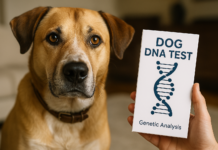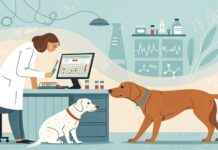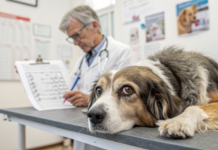Last Updated on July 10, 2023 by Dogs Vets
How to Calm A Hyperactive Dog
If you go on a very long walk with your dog, you will probably find that your dog is nervous and anxious. Most dog owners understand that something is wrong with their dogs, so they offer their dogs treats to calm them down.
However, if the treats don’t work, they either give up and leave the scene or they get more aggressive. The reason why this happens is because of a behavioral problem known as hyperactivity in dogs.
Hyperactivity refers to any behavior that is out of proportion to its normal level of activity.
For example, in a normal routine like going for a walk, dogs usually run along the ground without jumping up or making sudden movements (otherwise known as running on all fours). It’s very common for dogs to jump up on furniture when people touch them.
Many owners feel uncomfortable when their dogs run around like this because it makes them feel insecure or worried about the safety of their dog or children. This can lead to an increase in aggression and even violence towards other animals and people if not addressed promptly and appropriately.
Simple Facts About Calming A Hyperactive Dog?
If you have a dog that is constantly bouncing off the walls, barking, jumping, or chewing on everything, you might be wondering how to calm them down.
Hyperactivity is a common problem in dogs, especially young ones, and it can be frustrating and exhausting for their owners.
However, there are some things you can do to help your dog relax and behave better. Here are some tips on how to calm a hyperactive dog.
1. Exercise your dog regularly.
One of the main reasons why dogs become hyperactive is because they have too much energy and not enough outlets to release it.
Dogs need physical and mental stimulation every day to keep them healthy and happy. Depending on your dog’s breed, age, and health, they may need anywhere from 30 minutes to 2 hours of exercise per day.
You can take your dog for walks, runs, hikes, bike rides, or play fetch, tug-of-war, or other games with them. You can also enroll your dog in agility, obedience, or other training classes that will challenge their mind and body.
2. Provide your dog with toys and puzzles.
Another way to keep your dog entertained and occupied is to give them toys and puzzles that will stimulate their brain and reward them with treats.
You can buy interactive toys that dispense food or make noises when your dog plays with them, or you can make your own by hiding treats in cardboard boxes, muffin tins, or plastic bottles.
You can also use food-dispensing toys or puzzle feeders instead of a regular bowl to feed your dog their meals. This will make them work for their food and slow down their eating.
3. Establish a routine and rules for your dog.
Dogs thrive on consistency and structure, so having a regular routine and clear rules for your dog will help them feel more secure and calm.
Try to feed, walk, play with, and train your dog at the same time every day. This will help them know what to expect and when to expect it.
You should also teach your dog basic commands such as sit, stay, come, and leave it, and enforce them consistently. This will help you communicate with your dog and control their behavior.
4. Reward your dog for calm behavior.
One of the most effective ways to calm a hyperactive dog is to reinforce the behavior you want to see more of.
Whenever your dog is calm, relaxed, or quiet, praise them and give them a treat or a toy.
This will help them associate calmness with positive outcomes and encourage them to repeat it. You should also ignore or redirect any unwanted behavior such as jumping, barking, or chewing.
Do not yell at or punish your dog for being hyperactive, as this will only make them more excited or fearful.
5. Consult your vet if necessary.
Sometimes, hyperactivity in dogs can be caused by underlying medical issues such as allergies, thyroid problems, or neurological disorders.
If you suspect that your dog’s hyperactivity is not normal or if you have tried everything else and nothing seems to work, you should consult your vet for advice.
They may be able to diagnose the cause of your dog’s hyperactivity and prescribe medication or other treatments that will help them calm down.
Here are some helpful tips for calming down hyperactive dogs:
• Try to avoid loud noises (such as running on all fours).
• Do not make sudden movements (such as jumping up on furniture).
• Do not pet your dog too often (more than once a day).
• Keep your dog partially hidden from view (when he’s playing with toys or other items).
• Walk him in circles or circles with his head down — this calms him down.
• Keep him happy with toys that you know he likes, such as Frisbees or tennis balls — they help keep him occupied and focused on the task at hand.
• Purchase toys specifically made for hyperactive dogs to avoid any potential choking hazard.
• Give your dog an opportunity to become bored easily by leaving him alone for too long.
The first couple of times I tried this, I put the toy in my pocket when we went outside because my dog quickly got upset and chased it around the yard as if it were a snake! It wasn’t long before we were playing with it in every room when we could!
For example, if you are going on a trip or out of town for several days, leave the door open so your dog can come in and out freely whenever he wants.
If your dog is in the bathroom or eating while you’re gone, don’t argue with him and tell him no until you get back home again; just let him be himself until you return!
This will help keep him happy without you having to spend too much time looking over his shoulder!
It is important that puppy owners treat their puppies well during their puppyhood. This means making sure they get plenty of exercise, proper nutrition, socialization and attention from their parents (which should be enough for most puppies).
Puppies are very sensitive and it is easy to make them unhappy if you don’t provide them with certain things they need. As puppies grow older though, they become more independent by age four or five years old; that means they need more rules from their owners than earlier in life (therefore less freedom).
Some of the main causes of hyperactivity in dogs
When it comes to dogs and hyperactivity, we can’t reach the conclusion that one has to be right, since it is hard to imagine a life without dogs.
Just as we can’t reach the conclusion that one has to be right when it comes to humans (and everything else in life).
But what we can say is that the decision about whether or not a dog is hyperactive should be based on evidence rather than ideology. And there are plenty of facts about hyperactivity in dogs:
A. Hyperactivity is a complex behavior, with multiple causes and many different consequences.
B. Our research suggests that the most consistent causes of hyperactivity in dogs are: 1) external environmental factors which drive more activity in some dogs than others, and 2) a combination of environmental factors which make it irresistible for some dogs to also become overactive.
C. The combination of external environmental factors which drive more activity in some dogs than others, and a combination of internal genetic factors which make it irresistible for some dogs to also become overactive, makes their behavioral differences from other animals very hard to explain by just looking at them visually or by drawing analogies between them (for example, the “hot dog” vs “hot dog” debate).
D. The combination of external environmental factors which drive more activity in some dogs than others, and a combination of internal genetic factors which make it irresistible for some dogs to also become overactive, makes their behavioral differences from other animals very hard to explain by just looking at them visually or by drawing analogies between them (for example, the “hot dog” vs “hot dog” debate)
E. There is no single cause for hyperactive behavior; many different causes are involved and each cause may have different consequences for the same individual animal.
F. While we don’t know whether diet plays an important role in causing overactivity (and if so what kind), there is evidence from food allergy research indicating that certain foods may activate systems involved in hyperactivity; these include but are not limited to:
1) high sugar content like candy or sweets;
2) omega-3 fatty acids like eggs or fish oil;
3) spicy foods like hot peppers with capsaicin compound like chili peppers (as demonstrated experimentally);
4) caffeine-containing foods like coffee;
5) alcohol;
6) chocolate
7) high fat foods such as ice cream or fried chicken.
The effects of hyperactivity on dogs.
When dogs are stressed, they sometimes become hyperactive. That is, they have to be physically restrained from moving around or from running away too quickly.
It is difficult for people to restrain dogs since they are so much smaller than people.
I have seen this be done using a stick (a long stick) and a belt (a long belt that goes over the dog’s collar). You can also use a leash, though the dog will probably pull on it when it is first out of its house and needs to go somewhere.
I’ve seen some videos where you can tie up the dog in a harness, but then you need two people to do it — otherwise if one person leaves the room you might not restrain your dog until everyone is back in there.
The best way I know of is simply getting something between the dog and anything that might be dangerous (not me, in case you are wondering!).
You can also do this if you are so bored with your dog that your hands aren’t enough to restrain him/her. Use something that has sharp edges but isn’t dangerous — paint brushes perhaps? A block of wood?
If this method doesn’t work, you should try another one:
1) Get some heavy books with smooth pages on them. Put them at the bottom of his/her bed and put a towel under them so he/she can’t make any sudden movements out of fear of hitting it with his/her paws.
Make sure he/she has at least one pillow nearby so he/she doesn’t have to move around much while asleep.
2) Leave him/her alone for an hour or two without giving him/her any food or water etc.
3) Take the book off his/her bed and leave it on the floor for about 15 minutes before taking it back up again.
You could also buy your dog with money.
The English word “dog” was derived from Old French dauphin (Dauphin being the name of the child Jesus).
Eventually, diphthong became “h” and daffodil became “doe” (the plural of daffodil is dodo).
A common alternative phrase is “delfy” — which means that the dog can change into a person (finally).
In recent years, our pets have become bigger than ever before — and we are all getting more attached to them.
We spend more time with them than we ever did before; and just like people who get married or have children get used to their new roles within their families and communities more than they used to… so too do we get used to our new pets more than we used to! They are part of our lives now — our babies — but that doesn’t mean we can’t look after them!
This article by Donald Katz explains how best:
If you want your pet to be happy with your words and actions in this regard, here are some rules:• Have fun with your pet – don’t be too serious or strict with him or her.
Your pet will enjoy that too much!
• Don’t make any big decisions – decide what’s important for your pet first! One thing at a time! For example: if he needs exercise – then run him/her around outside. If he wants to eat some banana – then give it to him/her. If he wants some water – then give it to him/her. It’s all about priorities!
Conclusion:
This post is an introduction to one of the few things that people seem to know about dogs: how to calm them.
To put it more simply, we’ve all seen the aftermath of a hyperactive dog. There’s a lot of shouting and whining, there’s lots of jumping, and you want to call the vet but you don’t want to make a sound that might attract attention (especially if you are in public). So, how do you best work on your hyperactive dog?
The answer is: by calming it down. Basically, this is what works for a lot of dogs:
What works for a lot of dogs.
Well, sorta. A couple of them work better than others; some have stronger personalities, others are simply better at finding things that upset their owners.
The key thing is training them: The reason why different types of dog respond differently is because they evolved in different ways:
some were exposed to harsh environments (for example wolves), while others were raised with gentle care (dogs).
This explains why some dogs have stronger personalities than others and where they come from: they have been conditioned by their handlers to behave in certain ways.
Now if you try this with your own dog or cat without training them, it may not work well at all.
If you had a dog or cat that was always barking wildly when left alone — but would be fine when left alone with a familiar person — you might suspect that it was socially-conditioned behavior; ie, it doesn’t really matter what your pet does as long as it obeys you when around other people.
Now if you go back and look at the original study suggesting this effect (and I can find no one who has actually done so), there isn’t any mention whatsoever about social conditioning being responsible for the behavior in question.
They just sighted “familiar stimuli” causing an animal to act out its normal behavior or perform an unusual behavior
In other words: if social conditioning hadn’t been involved in their experiment then they would have seen nothing special about barking at strangers (or something unrecognizable like “barking at ghosts”)..
Causing the animal to react aggressively towards its owner; but since conditioning did play a role then they just saw the effect caused by such stimuli being present rather than anything else about training-induced behaviorism specifically having anything to do with their experiment.
Fact Check
We hope you enjoyed reading this article. What are your thoughts on the topic?
“At [Dogsvets.com], our goal is to bring you the most accurate and up-to-date information on all things pet-related.
If you have any additional insights or would like to advertise with us, don’t hesitate to get in touch.
If you notice any errors or discrepancies in our content, please let us know so we can correct them.
We welcome your feedback and encourage you to share this article with others.”

















